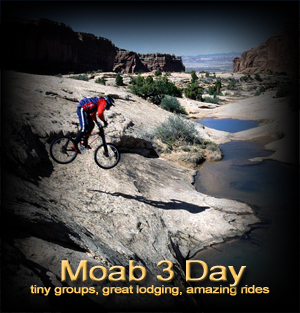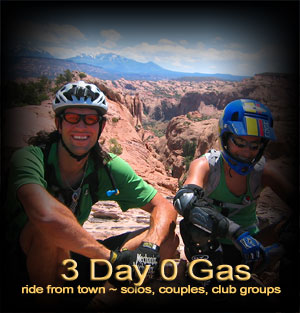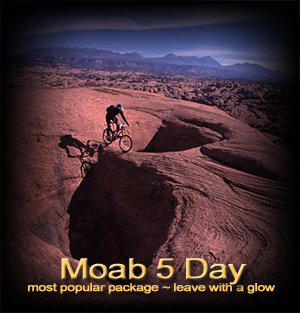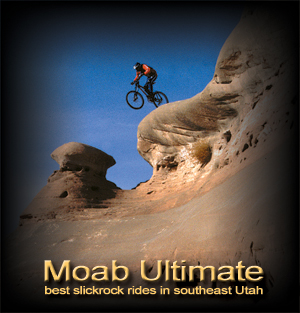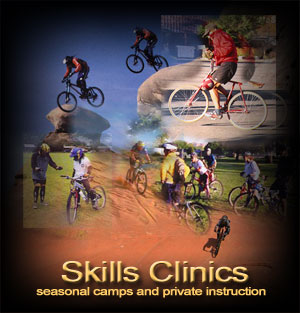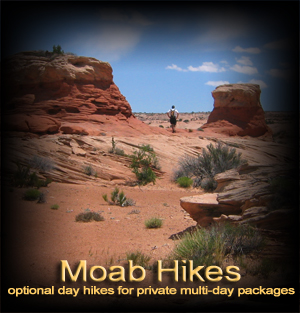WATER
A number of factors contribute to the amount of water
your body needs on any given ride--temperature, the amount of
effort you expend during the ride, the way you drink the water you have,
what you did before the ride, and what you had to drink or eat prior to
the ride.
I know an experienced rider ("Experienced But Lame") who once rode Porcupine Rim on a hot summer day. He carried three full water bottles, ran out at midpoint, and did not see another human being until the bottom of the trail. He barely survived. His mistake was not only to consider three waterbottles a lot of water for such heat and hard work, but he had consumed a pot of hot black tea prior to the ride. Black tea is a diuretic, forcing his body to pass water very
quickly. Beer or coffee have the same effect. Don't drink beer,
black tea, or coffee prior to a long hot ride. Drink a lot of good ole WATER.
Time of day is perhaps the least considered aspect
of hydration. Plan the ride schedule according to season. In summer begin
your ride before sunrise. Try to stay out of the midday summer sun.
If you are out on the trail from 6 to 10 AM you will
be rewarded with the most glorious time of day and cut your water consumption
more than in half compared to a midday ride. Don't think that you can leave later
in the day and avoid the heat. The red rocks absorb the sun's energy like
solar cells and radiate heat deep into the night. An afternoon
summer ride in canyon country is like placing yourself in a pre-heated oven.
If you must be out on the trail during the hottest hours of the day, take
a siesta in the shade. Shade is a hard thing to find in a desert environment, so you will have to search for it.
Exposure and dehydration are tricky. You will
not feel the effects until it is too late. Dehydration plays with
your perception. If you are dizzy, drink. If you are running out of water and you are dizzy, do not conserve, drink! Conserve energy, not liquids. If you have to drink out of a mud hole, remember, giardia is usually not fatal. It's better to crap in your pants tomorrow than die on the trail today.
If you rode a particularly difficult trail the previous day, your body is
still in the process of re-hydrating. You will need more water the second
day, so take more with you.
Know a diabetic? Sharing an energy bar could save a life. Carry one or two more candy bars than you need. Share! If you don't feel like you need the sugar, though, don't force it. Sugar can be poison.
FLASH FLOODS: Too little water is a serious problem, but too much water kills more tourists in canyon country than anything. Lack of water comes in a close second but some would argue that ignorance kills more people in general. As guides, we have experienced numerous flash floods while on rides in the desert. Some folks just cannot understand when they hear that thunderstorms pop up on a day that started with clear blue skies. Flash floods are dangerous and can be very beautiful--simply astonishing to watch. The power of flowing water is deceptive. Do not venture into rushing waters in an arroyo or desert wash, even if they don't look severe. Know the weather forecast (even if it is worthless) and prepare for the worst ALWAYS. Get to high ground and do not hang out under loose rock or sandstone arches that may crumble with moisture. If you find shelter make sure it is stable and away from water courses. A flash flood can come from a storm you don't even see, so do not linger unnecessarily in deep canyons or in a wash without paying strict attention to the water course. If there was no water in the wash and suddenly there is, or if clear water suddenly becomes muddy, get out of there and up onto the wall of the canyon. Drop your bike and climb up if you sense immediate trouble. If you hear a rumble, it is too late.
Always carry rain gear even if the sky is blue and the forecast calls for the driest of days. Space blankets are a real life saver, as are disposable ponchos and large garbage bags. During summer storms the temperature will drop as much as fifty degrees IN A MATTER OF SECONDS. Hail can be extremely dangerous both as projectiles and as a cause of hypothermia. Some hail falls like small wet snowballs and sticks to you like frozen glue.
Click on NATIONAL LIGHTNING SAFETY INSTITUTE for more in depth information.
Pissing on the desert: I have had to cuss at seemingly intelligent people for taking off across fragile desert soil crusts, after having been told not to, to take a piss behind a rock. I ask them not to do it, but they just go ahead anyway, as if having no perspective on environmental impact were a virtue, or as if I were some Sensitivity Training piss Nazi trying keeping them from peeing unless they do it RIGHT IN FRONT OF ME. It is not the pee pee that is the problem, really. It is behavior. COYOTES and BOBCATS know WHERE to piss and shit in the natural world. We don't. By riding the trails you can see that the native animals do it in the trail. Marking territory is another issue, so don't even go there. Bare rock, dry sand washes, and on the trail are the best places to put a liquid that kills plants, and it is the best place to take a crap (imagine the social outrage at that concept). There are so few bodcats that their shit is a scientific sample worthy of inspection. There are so many humans that your crap is just smelly old crap. Do it in the hotel bathroom BEFORE you ride.
If your anxiety about taking a wiz around people is severe, then you need to readjust your thinkin'. Even shy people will piss in front of Mormon Elders, if given permission, reinforcement and the time to get the flow started. Our guides piss with their backs to you, men and women alike. They might ask you to turn around out of courtesy, but they never hike off to take a pee. If we are at the trailhead, we use the toilet if it is provided or pee behind the SUV. If you have to walk one hundred feet to behind a rock to take a pee, then maybe you should spend your mountain bike vacation where there are places where you can walk one hundred yards to a large object on stable ground. Moab is not that place. It is open, almost barren, treacherous, beautiful and covered with extremely fragile vegetation. Hydration is a most important concern for mountain bikers in Moab, especially during the summer months when temperatures often surpass 100 degrees
Fahrenheit during mid-day and into the late evening hours. It is advised
to take at least two full large water bottles and a bladder pack (100 oz. minimum) on ANY ride. This amount of water may be adequate for full day rides during the cooler days of fall, spring
and winter, but don't expect it to last more than four hours on a hot, strenuous ride in summer. For summer day rides of four to six hours take two or more water
large bottles and pack hydration system that can
carry at least 128 oz. of water. Stop at any spring along the trail and add
more water to your bottles, even if you don't think you'll need it. I carry a small water filter and water purification tablets with me on all rides, just in case I have to drink from a puddle. Always
err on the side of carrying too much water. If something bad happens you may have to live off of what you are carrying for as long as you are stuck out there. This is MOAB. It is a place, not a race. Carrying water is just what you do out here. If you are worried about having to carry more weight, then ride trails near town with someone else who carries more water than you. I once went over the bars and landed on my hydration pack, exploding the bladder, which saved me from injury. It was over 100 degrees and I was ten miles from a water source. I had two water bottles on the bike, one of which was full. A good rule is to drink from your bladder first, because you cannot see how much is left. After it is gone, put the water you have in the bottle into the bladder. Expect to be in the desert overnight or longer. If you expect the worse, the absolute worse probably will not happen, but then again . . . .
Hydration is a most important concern for mountain bikers in Moab, especially during the summer months when temperatures often surpass 100 degrees
Fahrenheit during mid-day and into the late evening hours. It is advised
to take at least two full large water bottles and a bladder pack (100 oz. minimum) on ANY ride. This amount of water may be adequate for full day rides during the cooler days of fall, spring
and winter, but don't expect it to last more than four hours on a hot, strenuous ride in summer. For summer day rides of four to six hours take two or more water
large bottles and pack hydration system that can
carry at least 128 oz. of water. Stop at any spring along the trail and add
more water to your bottles, even if you don't think you'll need it. I carry a small water filter and water purification tablets with me on all rides, just in case I have to drink from a puddle. Always
err on the side of carrying too much water. If something bad happens you may have to live off of what you are carrying for as long as you are stuck out there. This is MOAB. It is a place, not a race. Carrying water is just what you do out here. If you are worried about having to carry more weight, then ride trails near town with someone else who carries more water than you. I once went over the bars and landed on my hydration pack, exploding the bladder, which saved me from injury. It was over 100 degrees and I was ten miles from a water source. I had two water bottles on the bike, one of which was full. A good rule is to drink from your bladder first, because you cannot see how much is left. After it is gone, put the water you have in the bottle into the bladder. Expect to be in the desert overnight or longer. If you expect the worse, the absolute worse probably will not happen, but then again . . . .
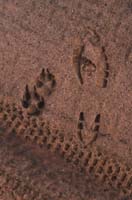 The way you drink has an effect on how much you absorb. A pack mounted bladder,
that delivers water to your mouth via a bite valve accessed
any time during the ride without using hands, is a powerful
tool for efficient hydration. If you sip water constantly, you will fight off
the first symptom of dehydration--thirst. When
you have a craving thirst it is too late for effective hydration.
The way you drink has an effect on how much you absorb. A pack mounted bladder,
that delivers water to your mouth via a bite valve accessed
any time during the ride without using hands, is a powerful
tool for efficient hydration. If you sip water constantly, you will fight off
the first symptom of dehydration--thirst. When
you have a craving thirst it is too late for effective hydration.
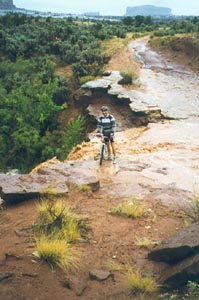 If you come across a severely dehydrated person, do not give him ice water or cold liquids. This induces shock and kills much quicker
than the dehydration. Give warm water only and force the person to slowly sip, not gulp.
If you come across a severely dehydrated person, do not give him ice water or cold liquids. This induces shock and kills much quicker
than the dehydration. Give warm water only and force the person to slowly sip, not gulp.
LIGHTNING: In the Moab area we loose a couple of folks every year to lightning. Golfers and climbers seem to be the most vulnerable to the effects of electricity. Raise a metal rod into a thunderstorm and "zap." Climb to the highest spot and "zap." If you are mountain biking through short trees that look like they have been burned black and you are on a high ridge in a thunderstorm, you are definitely in the wrong place at the wrong time. Flat or open desert is really dangerous as well. No place to hide, and your bike is a lightning rod. Get far away from it and find a low spot that is not directly under a tree or standing rock. Squat down very low to the ground and get up on the balls of your feet. The idea is to create as little contact with the ground as possible, presenting a very low profile. Don't be an isolated vertical object, and don't be connected to one in any way. Know where safe shelter is located and anticipate reaching shelter before lightning is a threat. The distance to lightning can be calculated by counting 5 seconds for every mile the lightning is away from you. Safe shelter must be reached before a flash is 2 to 3 miles away, which is 10 to 15 seconds flash-to-bang. Pay much more attention to the lightning than the rain. Quickly growing storms are extremely dangerous and can kill with the first flash. A storm may appear to be finished, but exercise caution any time clouds are dark. After or before the time of a storm is when lightning is most intense. The weak storm without too many flashes, at the edge of a larger storm, or early or late in the life of a storm is the most dangerous. A vehicle with a metal roof provides best shelter, so try to get back to your vehicle before the storm arrives. You can be struck by lightning from a storm as far as seven miles away. There are many types of lightning, so be educated. And remember that rubber tires do not insulate you from an electrical charge. Here is a good way to know: When it is cold and dry in your house, hang your bike on the ceiling, shuffle your feet on the carpet and then touch the rubber on the tire. Zap.
And for Christ sake, take a piss.
This section on taking a pee was added at special request by a client who rode hard with us for five days, based hydration stradegy around not peeing (for whatever reason), tried not to stop and pee, and when she got home she got really, really sick.
In certain European countries every busy street corner or public square has a hole in the pavement with a metal privacy screen around it. People pee. It is a fact of life, . . . but certain people are uptight about it. Some American MALES will hike one hundred yards over cryptobiotic soil crusts to piss on a rare desert flower behind a mountain as long as no one can see the package or hear the flow. More than one American FEMALE will hold her pee until the cows come home or until she gets a really bad bladder infection and the doctor tells her that she MUST pee when she needs to. Americans are so hung up about peeing that you can buy drugs at the supermarket that keep you from feeling like you have to pee. "Gotta go. Gotta go. Gotta go. Right now. Gotta go. Gotta go. Gotta go." For Christ sake, lady, take a leak.








